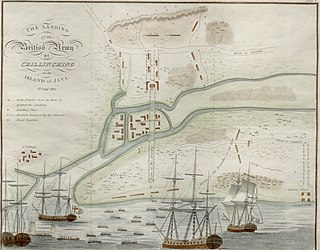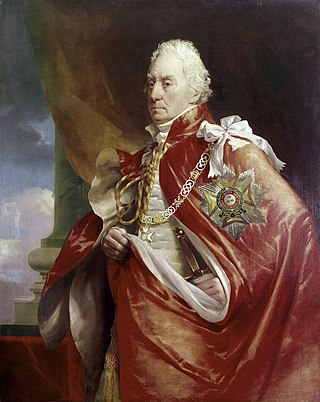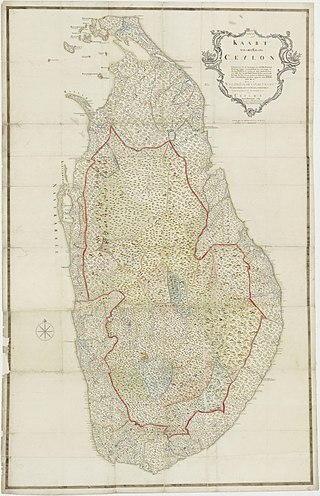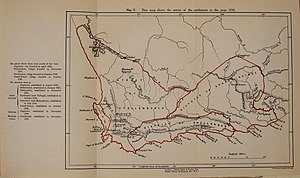
The Cape Colony, also known as the Cape of Good Hope, was a British colony in present-day South Africa named after the Cape of Good Hope. It existed from 1795 to 1802, and again from 1806 to 1910, when it united with three other colonies to form the Union of South Africa, then became the Cape Province, which existed even after 1961, when South Africa had become a republic, albeit, temporarily outside the Commonwealth of Nations (1961–94).

The Invasion of Java in 1811 was a successful British amphibious operation against the Dutch East Indian island of Java that took place between August and September 1811 during the Napoleonic Wars. Originally established as a colony of the Dutch Republic, Java remained in Dutch hands throughout the French Revolutionary and Napoleonic Wars, during which time the French invaded the Republic and established the Batavian Republic in 1795, and the Kingdom of Holland in 1806. The Kingdom of Holland was annexed to the First French Empire in 1810, and Java became a titular French colony, though it continued to be administered and defended primarily by Dutch personnel.

George Keith Elphinstone, 1st Viscount Keith, was a British naval officer active throughout the Napoleonic Wars.

The Battle of Blaauwberg, also known as the Battle of Cape Town, fought near Cape Town on Wednesday 8 January 1806, was a small but significant military engagement during the War of the Third Coalition, one of the Napoleonic Wars. After a British victory, peace was made under the Treaty Tree in Woodstock establishing British control over the Dutch Cape Colony. The Cape later became a permanent part of the British Empire following the Congress of Vienna that marked the end of the Napoleonic Wars in 1814. By establishing permanent British rule over the Cape Colony the battle would have many ramifications for the southern Africa region during the nineteenth and twentieth centuries. A bi-centennial commemoration was held in January 2006.
Rear-Admiral John William Spranger was a Royal Navy officer active during the French Revolutionary Wars and Napoleonic Wars.

Vice-admiral Jonkheer Theodorus Frederik van Capellen, GCMWO, KCB was a Dutch naval officer. He was married to Petronella de Lange (1779–1835). Alexine Tinne, female explorer and pioneering photographer, was his granddaughter.

The Cape Colony was a Dutch United East India Company (VOC) colony in Southern Africa, centered on the Cape of Good Hope, from where it derived its name. The original colony and the successive states that the colony was incorporated into occupied much of modern South Africa. Between 1652 and 1691, it was a Commandment, and between 1691 and 1795, a Governorate of the VOC. Jan van Riebeeck established the colony as a re-supply and layover port for vessels of the VOC trading with Asia. The Cape came under VOC rule from 1652 to 1795 and from 1803 to 1806 was ruled by the Batavian Republic. Much to the dismay of the shareholders of the VOC, who focused primarily on making profits from the Asian trade, the colony rapidly expanded into a settler colony in the years after its founding.

The Batavian navy was the navy of the Batavian Republic which was a continuation of the Staatse vloot of the Dutch Republic. Though thoroughly reorganized after the Batavian Revolution of 1795, the navy embarked on several naval construction programs which, at least on paper, made it a serious rival of the Royal Navy during the War of the Second Coalition. However, the Capitulation of Saldanha Bay, the Battle of Camperdown and the Vlieter incident showed that the navy did not measure up to that expectation. Nevertheless, the reorganizations proved to be durable, when the Batavian Republic was succeeded by the Kingdom of Holland, and later, the Kingdom of the Netherlands which makes the present-day Royal Netherlands Navy expected to trace its ancestry through it.

The action of 22 August 1795 was a minor naval engagement during the French Revolutionary Wars between a squadron of four British Royal Navy frigates and two frigates and a cutter from the Batavian Navy. The engagement was fought off the Norwegian coastal island of Eigerøya, then in Danish Norway, the opposing forces engaged in protecting their respective countries' trade routes to the Baltic Sea. War between Britain and the Batavian Republic began, undeclared, in the spring of 1795 after the Admiralty ordered British warships to intercept Batavian shipping following the conquest of the Dutch Republic by the French Republic in January 1795.

The Invasion of Ceylon was a military campaign fought as a series of amphibious operations between the summer of 1795 and spring of 1796 between the garrison of the Batavian colonies on the Indian Ocean island of Ceylon and a British invasion force sent from British India. The Dutch Republic had been a British ally during the French Revolutionary Wars, but was overrun by the French Republic in the winter of 1794 and reformed into the client state of the Batavian Republic. The British government, working with the exiled Stadtholder William of Orange, ordered the seizure of Batavian assets including colonies of the former Dutch Empire. Among the first territories to be attacked were those on the coast of the island of Ceylon, with operations initially focused on the trading port at Trincomalee.
The Dutch sloop Sireene was launched in 1786. The British captured her in 1796 at the capitulation of Saldanha Bay. She then served in the Royal Navy, first briefly as the sixth rate HMS Daphne, and then from 1798 as the prison ship HMS Laurel. The Admiralty sold her in 1821.
HMS Euphrosyne was an American brig that Vice-Admiral George Elphinstone purchased for the Royal Navy at Simon's Bay in 1796 in preparation for his attack on the Dutch squadron at Saldanha Bay. She was sold in 1802.

HMS Crescent was a 36-gun Flora-class frigate of the British Royal Navy. Launched in 1784, she spent the first years of her service on blockade duty in the English Channel where she single-handedly captured the French frigate, La Reunion. In 1795, Crescent was part of a squadron commanded by George Elphinstone, that forced the surrender of a Batavian Navy squadron at the capitulation of Saldanha Bay. After serving in the West Indies, Crescent returned to home waters and was wrecked off the coast of Jutland on 6 December 1808.

The Staaten Generaal was a Dutch 74-gun third rate ship of the line which served in the navy of the Dutch Republic and the Batavian Republic. The order to construct the ship was given by the Admiralty of the Meuse. The ship was commissioned in 1786.

The East Indies theatre of the French Revolutionary Wars was a series of campaigns related to the major European conflict known as the French Revolutionary Wars, fought between 1793 and 1801 between the new French Republic and its allies and a shifting alliance of rival powers. Although the Indian Ocean was separated by vast distance from the principal theatre of the conflict in Western Europe, it played a significant role due to the economic importance of the region to Great Britain, France's most constant opponent, of its colonies in India and the Far Eastern trade.

The action of 9 September 1796 was an inconclusive minor naval engagement between small French Navy and British Royal Navy squadrons off northwestern Sumatra, near Banda Aceh, during the French Revolutionary Wars. The French squadron comprised six frigates engaged in commerce raiding against British trade routes passing through captured parts of the Dutch East Indies, and posed a considerable threat to the weakened British naval forces in the region. The British force consisted of two 74-gun ships of the line hastily paired to oppose the eastward advance of the French squadron.

The Capitulation of Saldanha Bay was the surrender in 1796 to the British Royal Navy of a Dutch expeditionary force sent to recapture the Dutch Cape Colony. In 1794, early in the French Revolutionary Wars, the army of the French Republic overran the Dutch Republic which then became a French client state, the Batavian Republic. Great Britain was concerned by the threat the Dutch Cape Colony in Southern Africa posed to its trade routes to British India. It therefore sent an expeditionary force that landed at Simon's Town in June 1795 and forced the surrender of the colony in a short campaign. The British commander, Vice-Admiral Sir George Elphinstone, then reinforced the garrison and stationed a naval squadron at the Cape to protect the captured colony.
HMS Berbice was the Batavian Republic's schooner Serpent that HMS Heureux took possession of at Berbice in 1803 at the capitulation of the colony and that the Navy purchased in 1804. Berbice foundered in 1806 off Demerara.
The Lisbon station also known as Lisbon Station and Coast of Spain was a formation of the British Navy operating off the coast of Portugal from 1779 to 1782 before being disbanded and then again from 1783 until 1841.
Engelbertus Lucas was a Dutch naval officer, who as a rear-admiral, commanding a squadron of the Batavian Navy, was forced to surrender that squadron on 17 August 1796 at Saldanha Bay to a Royal Navy squadron under Vice-Admiral George Elphinstone.


















